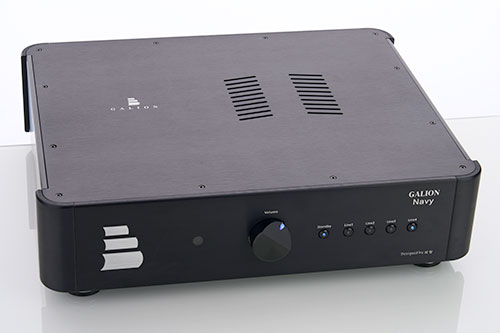Five years ago, Chord Electronics began to establish a new top-end line with the Ultima preamplifiers, as well as mono and stereo power amplifiers. Now the British company has added an Ultima integrated amplifier to make their high quality standard accessible to fans of more compact audio systems.
Just as a reminder: John Franks originally built high-quality electronics for the aviation industry, in particular a reliable power supply for fighter jets. Following his passion, he founded Chord Electronics Ltd. in 1989 to manufacture high-end audio electronics. His audio career got started with amplifiers for the BBC, later for Abbey Road Studios, Sony Music in New York and the Royal Opera in London. John Franks is responsible for the entire concept of the amplifiers, including their unique appearance. And here we already get to a point where opinions might differ: The Ultima Integrated shows up with a very unusual, striking appearance. Such an original design undoubtedly catches the eye of every guest in the living room equipped with such a kind of music system. My own opinion on this matter will not play a role in this review or in the respective assessment, but I would still like to share it with you. I like this casing design so much that I would be prepared to put up a little more money for it at the dealer's counter. Then again, I don't quite identify with the colourful illumination concept of the Ultima Integrated, which we repeatedly encounter in a similar form throughout Chord’s portfolio. This colourfulness is not only to be found on the control elements, but is also visible from the inside thanks to the air-permeable housing, which of course primarily serves cooling purposes. As on standby, the Ultima Integrated always contents itself with a minimum power requirement of less than one watt by waiving a main power switch, thus making it therefore always ready to play and having the central power button on the 28 millimetre thick front panel made of aircraft-grade aluminum constantly illuminated in red. At the North-German Hi-Fi Days I talked to Chord Electronics representative Doug Graham at the exhibition stand of Drei H, the German distributor. Doug Graham openly admitted that this particular styling is John Frank's design preference and therefore ex cathedra and irrevocable, so to speak. But here’s the all-clear: With regard to the lighting, a dimmer button on the pleasantly tactile remote control included in the scope of delivery allows the brightness to be significantly reduced. This also allows for the red light to glow discreetly when in standby mode. And if you don't appreciate the unusual design of the Ultima, don't worry. Because instead you can also opt for black side blocks made of gloss acrylic at no extra charge. A photo taken by my colleague Finn Corvin Gallowsky at the North-German Hi-Fi Days back in 2023 shows an Ultima preamplifier in this optional design.

Over the course of this review, we are primarily concerned with listening and the musical qualities. Anyone for whom the 10,000 Euros asking price is not too much of an expense, and I would like to say this in advance, should by any means listen to the Chord Ultima Integrated. Its sonic performance is as remarkable as its design is original. By briefly pressing the power button or using the IR system remote control, you can switch-on the amplifier ready to play. The red illumination then changes to a pastel green, which is pleasingly characterized by the fact that, even when not dimmed, it does not penetrate the eyes as many green LEDs commonly do. On the left of the front panel is the volume control knob to be found, which can be operated remotely thanks to the Alps Blue-Velvet motorized potentiometer and is surrounded by a circle of light that changes its colour depending on the selected input - one to four. For example, this ring lights up red for XLR line input one and yellow, green or blue for RCA inputs two, three and four. The four inputs are selected either using the remote control or by pressing the volume control knob once or several times. The selection of the inputs on the device is made in ascending order in one direction, which should not be a problem at all with merely four inputs, whereas the remote control conveniently allows a direct selection. Arranged symmetrically to the volume control on the left side, to the right of the power button sits the balance control, which is motorized as well and is always illuminated in a subtle white colour. This only changes to violet when the balance control is pressed until it starts clicking softly until the AV mode is activated. This is also possible by using the remote control. In AV mode, the selected input is bypass-looped straight to the output stage without level correction and signal processing within the preamp. Like the volume control, the balance control also has a distinctive notch for positional orientation that is clearly visible from a distance. Initially, I was a little perplexed, but after a short period of familiarization I really liked the fact that the balance control does not have a zero detent. This really forces you to adjust it by ear. I like this special feature because the zero detent otherwise has something compelling about it and the purist in me is reluctant to deviate from it. The control range is very fine in the centre area and only becomes more intensive towards the left or right end. This makes optimum tuning to the listening position child's play and rewards you with the feeling of sitting in the best seat in the concert hall.


























 |
|
















































































